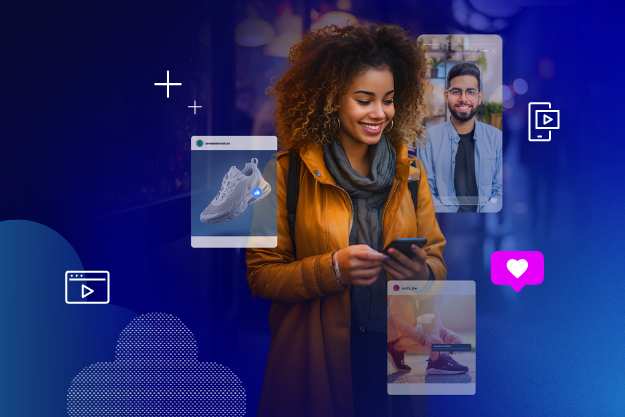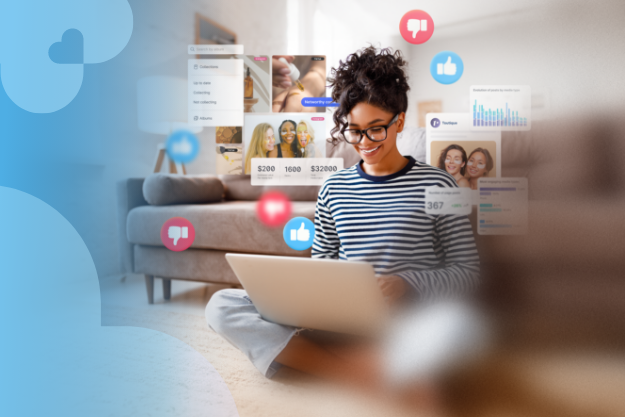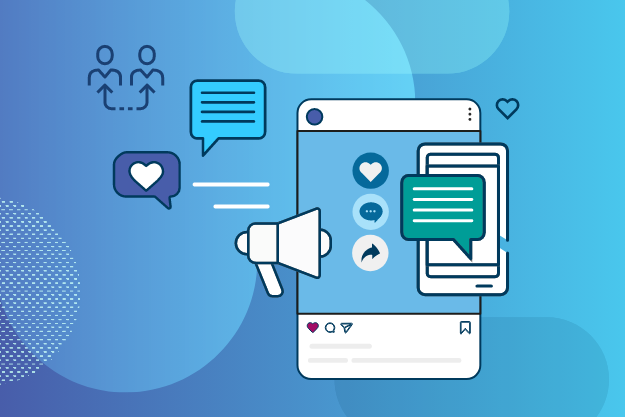User-generated content (UGC) has become a key part of any successful digital marketing strategy, allowing brands to authentically engage with customers, build relationships, and foster loyalty. If you’re not sure how much UGC might be out there for your brand to use, you might be surprised how many of your loyal customers are sharing their enthusiasm on social media, and how easy it is to get started with using that content for your own marketing.
Some of the most obvious uses for UGC involve social posts, but let’s dive deeper and look into the benefits of taking that awesome fan-created content and using it in other interesting ways.
Why UGC is such a versatile marketing tool
UGC is a highly versatile marketing tool that brands can use to promote brands and engage customers in a variety of ways. There are several qualities that help to give UGC a wide breadth of potential uses as a marketing content channel:
Authenticity and credibility
UGC is created by real users, providing an authentic and genuine perspective on products or services.
Consumers often trust content generated by their peers more than traditional advertising, contributing to increased credibility.
Engagement and community building
Encouraging users to contribute content fosters a sense of community around a brand.
Interactive campaigns and challenges that involve UGC can boost engagement and create a loyal customer base.
Diverse content formats
UGC comes in various formats, including photos, videos, reviews, testimonials, and more.
This diversity allows brands to leverage different types of content across various platforms, catering to the preferences of their audience.
Cost-effective marketing
UGC minimizes the costs associated with content creation, as users willingly provide material.
Brands can repurpose UGC across multiple channels, maximizing its value without significant additional expenses.
Audience connection
UGC enables brands to connect with their audience on a personal level.
When customers see their content being featured, it creates a sense of recognition and strengthens the bond between the brand and its community.
Scalability
As your user base grows, so does the potential for UGC.
Brands can tap into a scalable source of content without the need for continuous, resource-intensive production.
SEO benefits
UGC often includes valuable keywords and phrases related to products or services.
Search engines may favor content that is rich in relevant keywords, contributing to improved search rankings.
Dynamic and timely content
UGC is dynamic and reflects current trends and customer sentiments.
Brands can stay relevant by incorporating timely UGC into their marketing strategy.
Social proof
Positive UGC serves as social proof, demonstrating the satisfaction of existing customers.
Potential customers are more likely to trust a product or service that others have endorsed.
Cross-platform integration
UGC can be seamlessly integrated across various marketing channels, including social media, websites, blogs, email campaigns, and print materials.
This flexibility allows for a cohesive and omnichannel marketing approach.
When your brand looks to maximize the overall impact of the UGC you collect, here are some of the ways you can pull it out of the social posting sphere and fully realize its potential.
1. Website
Incorporating UGC into your website is an effective way to demonstrate customer satisfaction and encourage potential customers to interact with your brand. Whether it's through reviews and ratings or testimonials or stories from satisfied customers — including UGC on your homepage or product pages is a great way to make your website more engaging for users.
Wallpaper and paint brand Farrow & Ball does this by incorporating several UGC widgets into their website, including product pages, inspiration galleries, and blog articles. That allows them to pull in relevant user-created images so potential customers can see real-life examples of their products being used in homes, and they can then share that content in emails and on social media.
Because there are so many different types of UGC, and they can appeal to a wide range of consumers, it’s a great marketing tool to add to your website mix. Some of the ways brands have effectively used it on their website include:
Product reviews and testimonials:
Feature customer reviews and testimonials on product pages to provide social proof and build trust.
Implement a rating system to showcase overall product satisfaction.
Visual galleries:
Create visual galleries showcasing photos or videos of customers using your products.
Allow users to submit their content and curate it into thematic galleries.
UGC campaigns and challenges:
Host UGC campaigns or challenges and display the winning entries on the website.
This not only encourages participation but also showcases the creativity of your audience.
Featured customer of the month:
Highlight a customer of the month or showcase a rotating selection of customers on the homepage.
Include a brief interview or feature to humanize the brand and connect with visitors.
Localized UGC:
If applicable, feature UGC from specific locations or regions to create a more personalized experience for visitors.
2. Blogs
Personalized blogs featuring customer stories provide an interesting way for customers to connect with your brand while ensuring valuable information is being provided about what they want and need from you. Incorporating UGC into blog posts not only brings credibility and authenticity to the content, but also generates more organic interest as users share it across various platforms.
Your blog is essentially a blank canvas for your marketing team to talk about topics they believe will interest your core audience, and UGC can offer the perfect accompaniment to that. It will not only enhance the content you’re already producing, but it will also bring a vibrancy to the content you won’t get by producing it all yourself. Some of the ways brands have effectively incorporated UGC into their blog include:
Embed social media posts:
Embed relevant social media posts (tweets, Instagram photos, TikTok posts) within the blog content.
Use these posts to highlight customer experiences, reviews, or mentions related to the blog topic.
Share customer stories:
Feature detailed customer stories or testimonials in blog posts.
Use storytelling techniques to narrate how customers have benefited from the brand's products or services.
Include visuals and media:
Incorporate user-submitted photos or videos that showcase real-life experiences with the brand.
Use visuals to complement and enhance the narrative of the blog post.
Highlight UGC in roundup posts:
Create roundup posts that compile the best UGC related to a specific theme or campaign.
Showcase a variety of content types, such as photos, videos, and quotes from users.
Curate user-generated reviews:
Integrate user reviews and ratings directly into blog posts, especially if the post is related to specific products or services.
Use positive reviews to support the points made in the content.
Showcase before-and-after transformations:
If applicable, feature UGC that demonstrates before-and-after transformations using the brand's products or services.
This visual storytelling technique can be compelling and persuasive.
3. Email campaigns
One of the best aspects of email is how easy it is to segment and personalize your campaigns, as long as you’ve taken care to keep your data clean and organized. You can create different variables and data-driven modules that deliver various content based upon whatever you know about the recipient. The only limits are your imagination and your data.
That gives UGC an incredible stage on which to perform, where you can categorize and set up various UGC content that’s tailored to each specific audience you’re sending to, giving it a relevance and resonance that it might not have in any other setting. Some of the ways brands have effectively incorporated UGC into email campaigns include:
Product reviews and testimonials:
Include snippets of positive product reviews and testimonials in email campaigns.
Highlight specific benefits or features that customers have praised to reinforce the product's value.
UGC contest announcements:
Promote UGC contests in email campaigns and encourage customers to participate.
Showcase entries from previous contests to inspire participation and demonstrate the vibrant community around the brand.
Customer spotlight emails:
Send emails that feature a customer or brand ambassador spotlight.
Include a brief interview, photos, or videos that showcase the customer's experience with the brand.
UGC-driven content series:
Create a series of emails that center around UGC content.
For example, a weekly email featuring the best customer photos, stories, or reviews received by the brand.
Personalized recommendations with UGC:
Use UGC to personalize product recommendations in emails.
Recommend products based on what similar customers have liked or purchased.
Customer story campaigns:
Run email campaigns that tell the stories of different customers and how they use the brand's products.
Incorporate visuals, quotes, and other UGC elements to make the stories more compelling.
4. Print materials
Lots of people overlook this potential use for UGC, but utilizing UGC in print materials, such as brochures, flyers, and posters, makes them more personalized and relatable for potential customers. It also showcases existing customers’ satisfaction through their stories or feedback, which appears prominently in these materials, too.
Print materials aren’t typically going to have as many personalization options as email, but there’s plenty of room to test what works and what doesn’t. Especially if you have brick-and-mortar stores, you have tons of opportunities to introduce UGC into print materials you know will be seen as customers browse the store. Some of the ways brands have effectively incorporated UGC into marketing print materials include:
Brochures and catalogs:
Feature customer testimonials and reviews in product brochures or catalogs.
Include UGC visuals, such as photos or illustrations, to showcase real customers using and enjoying the products.
Printed advertisements:
Integrate UGC visuals into traditional print advertisements to capture attention.
Use real customer testimonials or quotes as part of the ad copy to provide social proof.
In-store posters and displays:
Design posters and in-store displays that prominently showcase UGC.
Include visuals and quotes that highlight the positive experiences of customers with the brand's products or services.
Event materials and signage:
Utilize UGC in event materials such as banners, signage, and promotional materials.
Showcase event-related UGC, such as attendee photos or testimonials, to build anticipation and engagement.
Limited-edition print collateral:
Design limited-edition print collateral that features exclusive UGC content.
This can create a sense of exclusivity and encourage customer engagement.
QR codes linked to UGC:
Include QR codes in print materials that link to UGC galleries or social media platforms.
This allows customers to explore more UGC content digitally.
Takeaways
When it comes to digital marketing strategies, UGC is an essential piece of the puzzle. It’s a powerful tool that can be used by businesses to create an authentic and honest voice for their brand, build relationships with customers, and gain valuable insights into customer wants and needs.
With UGC, businesses can create an atmosphere of ownership among customers — they'll feel like their opinion matters when they post about products or services they enjoy. Additionally, UGC can help increase website traffic and conversions, as well as fuel SEO efforts by including relevant keywords in content.
If you want to spread UGC beyond social media, though, it’s important that you have a UGC platform with the capability to help you do that easily. If you’d like to talk about how Emplifi can help you realize the full impact of the content your happy customers are already creating across every social channel, let’s talk about setting you up with a demo.




































